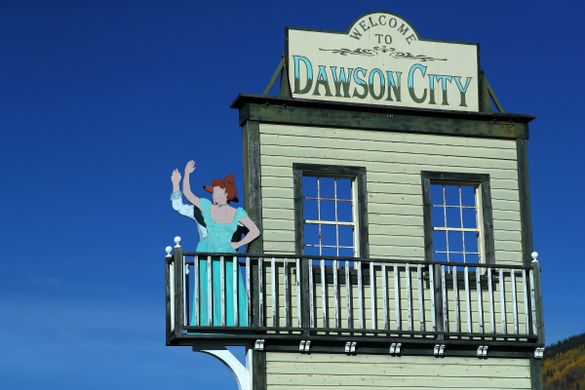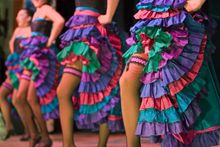 16 Feb 2021
16 Feb 2021
The Yukon celebrates the Klondike Women in the 125th Anniversary of the Gold Rush
This year, the Yukon Territory will be celebrating the 125th anniversary of the discovery of gold in the Yukon and the start of the notorious Klondike Gold Rush. The discovery of gold in 1896 began a stampede of more than 100,000 prospectors. However, it wasn't just men that left their homes to start the treacherous journey through the Yukon to find their fortunes. There were lots of women who played pivotal roles in the Klondike Gold Rush too, and against all odds, they forged their own way to Dawson City, and made successful lives for themselves.
The Klondike Women:
The Gold Discoverer - Shaw Tláa
From the Carcross/Tagish First Nation, Shaw Tláa (also known as Kate Carmack) discovered gold at Bonanza Creek with her bother Skookum Jim, her nephew Tagish Charlie and her husband, George Carmack. Their discovery started the stampede, which saw the four of them make their fortunes.
The Fearless Pioneer - Martha Black
At the height of the stampede, Martha – who was pregnant at the time – left her husband behind and hiked the infamous Chilkoot Trail with her bother. When she reached Dawson City, the female pioneer built her own log cabin. She would eventually become the second woman elected to the House of Commons of Canada.
The Queen of the Klondike – Kathleen Rockwell
Nicknamed Klondike Kate, Kathleen originally disguised herself as a man and joined a male-only scow to reach Dawson City. Klondike Kate's dancing and performing skills earned her the reputation for being the best entertainer in town but her charm and kindness saw her become known as Queen of the Klondike.
The Casino Superstar – Gertie Lovejoy
Hardcore Gertie Lovejoy, who always wore a diamond between her two front teeth, was one of the most iconic dance stars in Klondike, so much so, Dawson's iconic casino Diamond Tooth Gerties, was named after her. Visitors can still visit the legendary casino today and enjoy period-style, cancan entertainment and casino games.
Business-savvy Belinda Mulrooney
Belinda began her Klondike business as a prospector by selling hot-water bottles to stampeders en route to Dawson City. Along the way, she built roadhouses and cabins and used her profits to become a stakeholder in the Yukon's largest gold mine. She brought a touch of class to the Yukon and her biggest success was opening the luxury Fair View Hotel.
The Powerhouse – Lucile Hunter
Pregnant and only 19-year olds, Lucile and her husband Charles travelled one of the most difficult routes to Dawson and despite a stop to give birth to her daughter at Teslin Lake en route, they arrived before most of the other stampeders. Staking three claims in Bonanza Creek, the couple settled there and even after Charles died in 1939, Lucile continued to walk 200km every year to operate silver claims in Mayo, before moving to Whitehorse to run a laundry business.
Years ahead of the rest – Émilie Tremblay
A few years before the Gold Rush had even started, French-Canadian Émilie Tremblay was one of the first white women to successfully cross the Chilkoot Trail and she set up home in a one room cabin with her husband in Miller Creek. She earned a reputation across the Yukon by looking after some of the miners during the harsh winters and eventually opened the Mme Tremblay's Store in Dawson, which is now a recognised heritage building by Parks Canada and still in business today.
Gold in the Yukon today:
There's still gold in the Yukon but today it's the period's captivating history that draws visitors to the Territory. Gold Rush town, Dawson City, featured in Disney's The Call of the Wild movie released in February 2020, based on Jack London's classic novel and starring Harrison Ford.
Author Jack London was one of those brave people who survived the treacherous journey to the Yukon to find gold. Whilst he did not find his fortune in gold, he found it in the stories he wrote about his experiences in the Yukon and most famously, in The Call of the Wild. Jack London fans will love the Jack London Museum and Cabin in Dawson City. The interpretive museum tells the story of Jack's adventure in the Klondike and the subsequent hunt for his cabin where he lived during the winter of 1897.
While in Dawson City, visit the Dänojà Zho Cultural Centre to learn how the Tr'ondëk Hwech'in people lived on the land for thousands of years before the Gold Rush and how it changed their lives forever. The word “Klondike” itself is an anglicized version of the first half of the local First Nations name: “Tr'ondëk' Hwech'in” means “the people of the Klondike River”.
MacBride Museum in Whitehorse is home to over 40,000 artefacts which illustrate the stories of the Klondike Gold Rush as well as the Yukon's First Nations. The Yukon's stories live here and are told through engaging programs, storytelling and events.
MacBride Museum's Executive Director, Patricia Cunning said: “The stories of these strong women in the Klondike Gold Rush are important. We share these stories through showcasing objects owned by them including Klondike Kate's purses, Kate Carmacks's cape, and Martha Black's engagement ring among other treasures. Our Wayback Wednesday story nights detail the lives, accomplishments and the challenges these women faced building lives in the Klondike.”
Throughout the different seasons, visitors will find many ways to experience the Klondike Gold Rush heritage. The world-renowned Chilkoot Trail hike traces the prospectors' path from Dyea, Alaska, through the Yukon to Bennett, BC. Across the ravine, the White Pass and Yukon Route railway chugs over the pass. In between the trail and the tracks, a scenic highway winds through the coastal mountains to the charming village of Carcross (Yukon), home of the Carcross/Tagish First Nations.
Explore preserved paddlewheelers on shore or canoe some, or all, of the river route the gold seekers took from Bennett Lake to the Klondike. There are touches of the gold rush in everything from jewellery to coffee beans to outdoor art. Tour heritage buildings, pan for gold, stroll boardwalks and get to know larger-than-life gold rush characters as they share their gripping stories about the momentous event that changed the Yukon forever.
About the Yukon:
Situated in the upper Northwest corner of Canada, next to Alaska, the Yukon is Canada's most accessible northern destination. Home to Canada's highest mountain (Mount Logan) and the planet's largest non-polar icefields located in Kluane National Park - a UNESCO World Heritage site – the breath-taking Territory is truly a winter wonderland.
One of North America's most undiscovered destinations; close to 80 percent remains pristine wilderness with 5,000-metre peaks, forested valleys, unspoiled waters and untamed wildlife. Roughly the size of Spain at just over 300,000 square miles, the Yukon is home to more than 160,000 caribou, 70,000 moose, 22,000 mountain sheep, 7,000 grizzly bears, 10,000 black bears and 250 species of birds, with a human population of only 40,000.
The Yukon's population may be small, but its culture is grand. The Yukon is home to 14 First Nations and 8 indigenous language groups. Cultural events, festivals and celebrations abound year-round.
Winter is the longest season, spanning five months from November until the end of March, and there's a plethora of thrilling activities for adventurers to experience. For some, it's breathing in the white-clad beauty. Others hear the absolute silence. Some demand the physical challenges. Others exalt in the Northern Lights.
AmeriCan & Worldwide Travel offer an 'Aurora Klondike Experience' from £2512 per person including flights. For further information contact tel: 01892 779900 or visit www.awwt.co.uk





